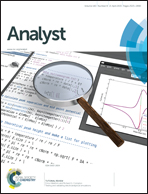Development of a fraction collection approach in capillary electrophoresis SELEX for aptamer selection†
Abstract
Aptamers have attracted much attention due to their ability to bind to target molecules with high affinity and specificity. The development of an approach capable of efficiently generating aptamers through systematic evolution of ligands by exponential enrichment (SELEX) is particularly challenging. Herein, a fraction collection approach in capillary electrophoresis SELEX (FCE-SELEX) for the partition of a bound DNA–target complex is developed. By integrating fraction collection with a facile oil seal method for avoiding contamination while amplifying the bound DNA–target complex, in a single round of selection, a streptavidin-binding aptamer (SBA) has been generated. The affinity of aptamer SBA-36 for streptavidin (SA) is determined as 30.8 nM by surface plasmon resonance (SPR). Selectivity and biotin competition experiments demonstrate that the SBA-36 aptamer selected by FCE-SELEX is as efficient as those from other methods. Based on the ability of fraction collection in partition and collection of the aptamer–target complex from the original DNA library, FCE-SELEX can be a universal tool for the development of aptamers.


 Please wait while we load your content...
Please wait while we load your content...